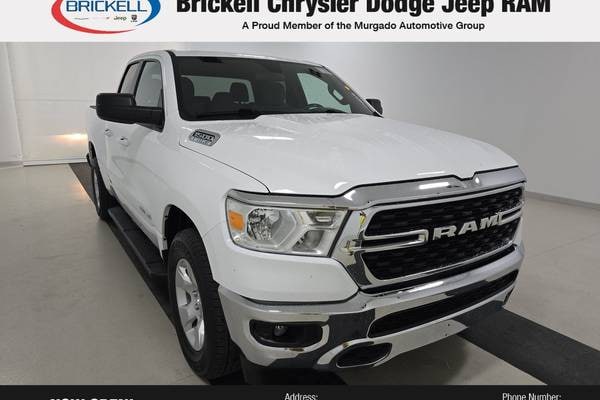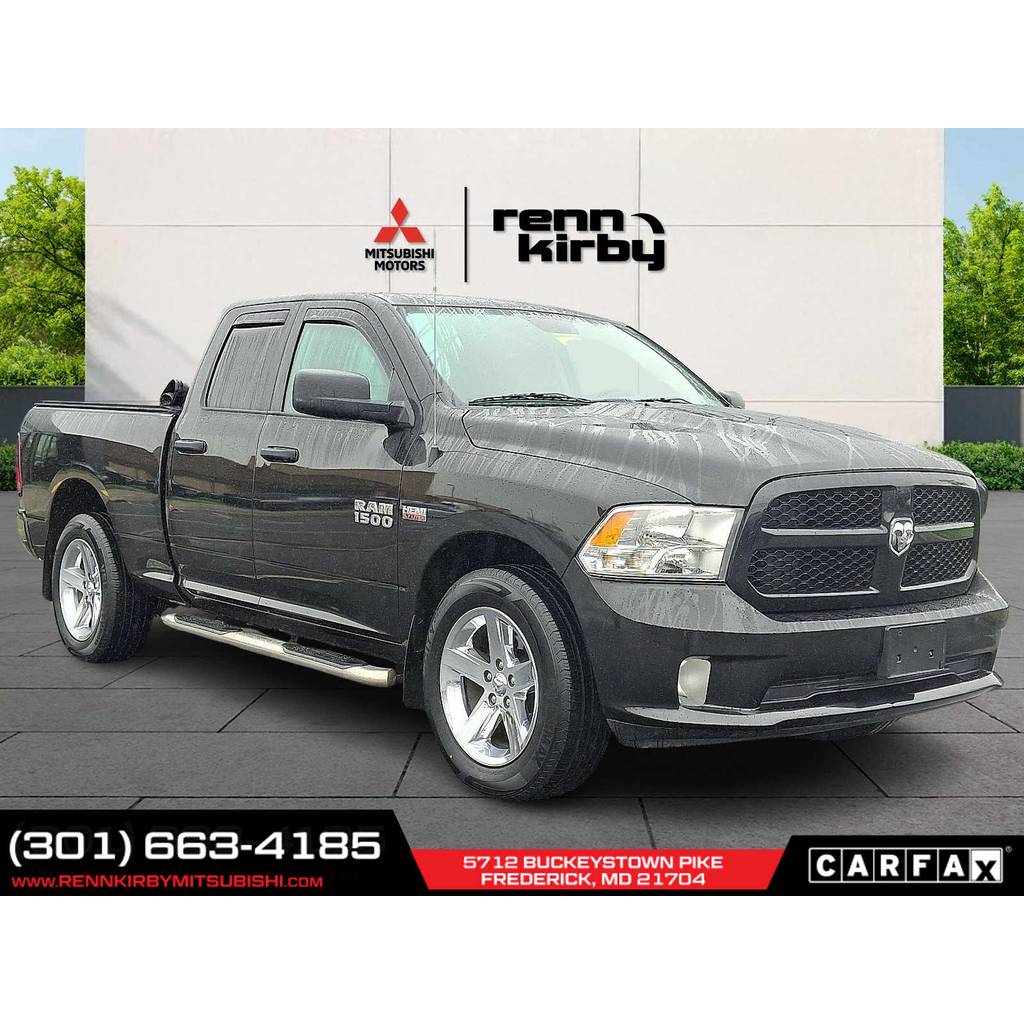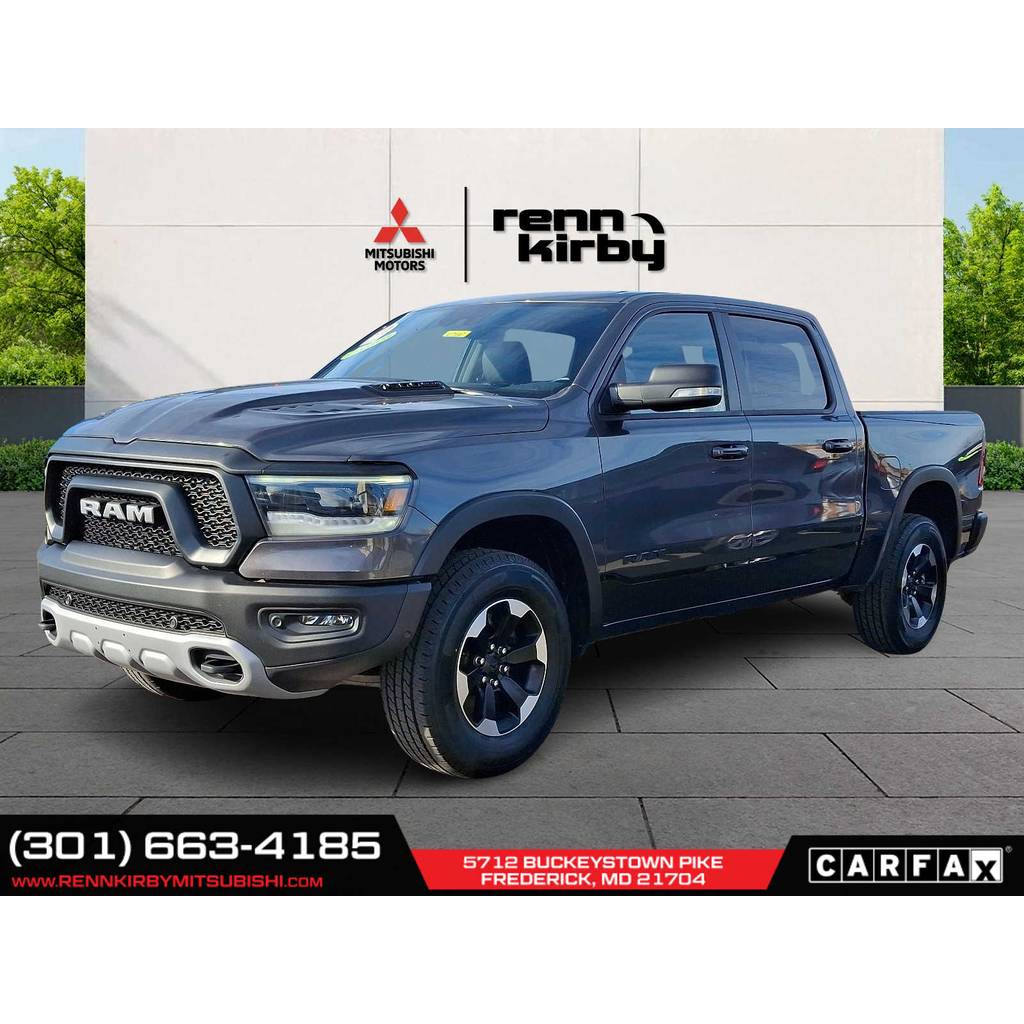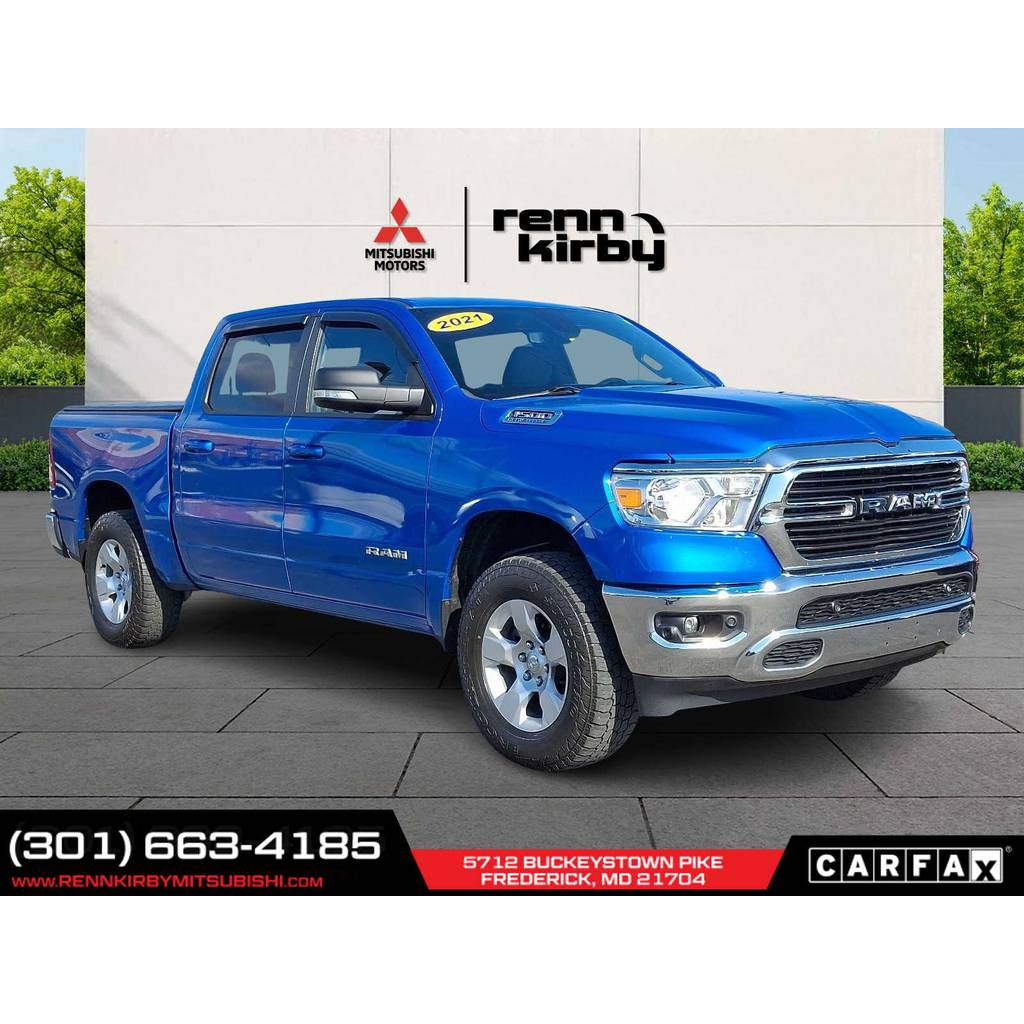- $21,755great price$6,505 below market
- 66,418 miles
- No accidents, 2 owners, corporate fleet vehicle
- 6'4” bed, 3.6l, 6cyl
- Brickell Chrysler Dodge Jeep Ram (Miami, FL)
Close
Located in Miami, FL / 930 miles away from Ashburn, VA
Bright White Clearcoat 2022 Ram 1500 Big Horn/Lone Star RWD 8-Speed Automatic 3.6L V6 24V VVTFind Your Perfect Pre-Owned Vehicle at Brickell Chrysle...
AutoCheck Vehicle History Summary
Accident Free Vehicle: Yes
Personal Use Only: No
History Provider: AutoCheck
Title Details: Clean Title
Salvage Vehicle: No
Frame Damage: No
Theft History: No
Lemon Status: No
Free History Report: No
Features and Specs:
22 Combined MPG (20 City/25 Highway)
Listing Information:
VIN: 1C6RREBG2NN273687
Stock: J1894
Certified Pre-Owned: No
Listed since: 06-03-2025 - $32,697great price$5,067 below market
- 22,370 miles
- No accidents, 1 owner, personal use
- 5'7” bed, 5.7l, 8cyl
- EchoPark Automotive Phoenix (Avondale) (Avondale, AZ)
Close
Located in Avondale, AZ / 1,965 miles away from Ashburn, VA
At EchoPark, it’s all about offering you options for a happy experience. We have thousands of new-to-you makes and models that range from sedans to tr...
AutoCheck Vehicle History Summary
Accident Free Vehicle: Yes
Personal Use Only: Yes
History Provider: AutoCheck
Title Details: Clean Title
Salvage Vehicle: No
Frame Damage: No
Theft History: No
Lemon Status: No
Free History Report: No
Features and Specs:
Listing Information:
VIN: 1C6RREFT1NN277687
Stock: PNN277687
Certified Pre-Owned: No
Listed since: 06-05-2025 - $49,997great price$6,792 below market
- 18,026 miles
- No accidents, 1 owner, personal use
- 5'7” bed, 5.7l, 8cyl
- Planet Chrysler Jeep Dodge Ram (Franklin, MA)
Close
Located in Franklin, MA / 383 miles away from Ashburn, VA
Own the road in this Granite Crystal 2022 Ram 1500 Rebel 12 Night Edition — a powerful and fully loaded full-size truck that turns heads and con...
AutoCheck Vehicle History Summary
Accident Free Vehicle: Yes
Personal Use Only: Yes
History Provider: AutoCheck
Title Details: Clean Title
Salvage Vehicle: No
Frame Damage: No
Theft History: No
Lemon Status: No
Free History Report: No
Features and Specs:
Listing Information:
VIN: 1C6SRFLT0NN344615
Stock: 4768
Certified Pre-Owned: No
Listed since: 06-03-2025 - $33,500great price$10,961 below market
- 94,669 miles
- No accidents, 1 owner, personal use
- 5'7” bed, 5.7l, 8cyl
- Rouen Chrysler Jeep Dodge Ram (Woodville, OH)
Close
Located in Woodville, OH / 355 miles away from Ashburn, VA
Diamond Black Crystal Pearlcoat 2022 Ram 1500 Laramie Certified. Leather, Heated and Cooled Seats, Navigation System, Touchscreen Controls, Backup Cam...
AutoCheck Vehicle History Summary
Accident Free Vehicle: Yes
Personal Use Only: Yes
History Provider: AutoCheck
Title Details: Clean Title
Salvage Vehicle: No
Frame Damage: No
Theft History: No
Lemon Status: No
Free History Report: No
Features and Specs:
Listing Information:
VIN: 1C6SRFJT3NN413977
Stock: X15357
Certified Pre-Owned: Yes
Listed since: 06-03-2025 - $80,232great price$10,516 below market
- 20,624 miles
- No accidents, 1 owner, personal use only
- 5'7” bed, 6.2l, 8cyl
- John Hiester Chrysler Dodge Jeep Ram of Sanford (Sanford, NC)
Close
Located in Sanford, NC / 260 miles away from Ashburn, VA
CLEAN CARFAX, ONE OWNER, 4WD, FAST AND EASY FINANCING, THE NEW PRICE OUTLET, #2 Seat Foam Cushion, 2-Door Passive Entry, Front Door Locks, 4 Way Front...
AutoCheck Vehicle History Summary
Accident Free Vehicle: Yes
Personal Use Only: Yes
History Provider: AutoCheck
Title Details: Clean Title
Salvage Vehicle: No
Frame Damage: No
Theft History: No
Lemon Status: No
Free History Report: No
Features and Specs:
12 Combined MPG (10 City/14 Highway)
Listing Information:
VIN: 1C6SRFU97NN168830
Stock: P9923
Certified Pre-Owned: No
Listed since: 05-31-2025 - $39,500great price$4,787 below market
- 27,800 miles
- No accidents, 1 owner, personal use only
- 5'7” bed, 5.7l, 8cyl
- Liberty Chevrolet (Wakefield, MA)
Close
Located in Wakefield, MA / 413 miles away from Ashburn, VA
New Price 2022 Ram 1500 LaramieAuto High Beam Headlamp Control, Bright Day Light Opening Moldings, Chrome Appearance Group, Chrome Tow Hooks, Foam B...
AutoCheck Vehicle History Summary
Accident Free Vehicle: Yes
Personal Use Only: Yes
History Provider: AutoCheck
Title Details: Clean Title
Salvage Vehicle: No
Frame Damage: No
Theft History: No
Lemon Status: No
Free History Report: No
Features and Specs:
Listing Information:
VIN: 1C6SRFJT7NN271116
Stock: 2502911
Certified Pre-Owned: No
Listed since: 06-02-2025 - $37,500great price$6,929 below market
- 40,619 miles
- No accidents, 1 owner, personal use only
- 6'4” bed, 5.7l, 8cyl
- Carhaven (Millersville, MD)
Close
Located in Millersville, MD / 46 miles away from Ashburn, VA
Advertised price includes a $1,000 dealer finance incentive. To qualify for this price, financing must be arranged through one of our dealer-approved ...
AutoCheck Vehicle History Summary
Accident Free Vehicle: Yes
Personal Use Only: Yes
History Provider: AutoCheck
Title Details: Clean Title
Salvage Vehicle: No
Frame Damage: No
Theft History: No
Lemon Status: No
Free History Report: No
Features and Specs:
Listing Information:
VIN: 1C6SRFRT8NN421531
Stock: M5294A
Certified Pre-Owned: No
Listed since: 05-31-2025 - $36,495great price
- 91,301 miles
- No accidents, 2 owners, personal use only
- 5'7” bed, 3l, 6cyl
- Family Toyota Burleson (Burleson, TX)
Close
Located in Burleson, TX / 1,195 miles away from Ashburn, VA
1500 Rebel, 4D Crew Cab, EcoDiesel 3.0L V6, 8-Speed Automatic, 4WD, Billet Silver Metallic Clearcoat, Red/Black w/Cloth/Vinyl Low Back Bucket Seats or...
AutoCheck Vehicle History Summary
Accident Free Vehicle: Yes
Personal Use Only: Yes
History Provider: AutoCheck
Title Details: Clean Title
Salvage Vehicle: No
Frame Damage: No
Theft History: No
Lemon Status: No
Free History Report: No
Features and Specs:
Listing Information:
VIN: 1C6SRFLM3NN403598
Stock: A307843A
Certified Pre-Owned: No
Listed since: 06-03-2025 - $30,499great price
- 60,095 miles
- No accidents, 1 owner, personal use only
- 5'7” bed, 5.7l, 8cyl
- Big Star Chrysler Jeep Dodge RAM FIAT Clear Lake (Webster, TX)
Close
Located in Webster, TX / 1,199 miles away from Ashburn, VA
CARFAX One-Owner. Certified.Big Star Chrysler Jeep Dodge Ram Fiat is delighted to offer this handsome 2022 Ram 1500. Big Horn/Lone Star 4WD Billet S...
AutoCheck Vehicle History Summary
Accident Free Vehicle: Yes
Personal Use Only: Yes
History Provider: AutoCheck
Title Details: Clean Title
Salvage Vehicle: No
Frame Damage: No
Theft History: No
Lemon Status: No
Free History Report: No
Features and Specs:
Listing Information:
VIN: 1C6SRFFT2NN312891
Stock: 312891A
Certified Pre-Owned: Yes
Listed since: 06-01-2025 - $22,985good price$2,475 below market
- 92,682 miles
- No accidents, 1 owner, personal use only
- 6'4” bed, 3.6l, 6cyl
- AutoNation Toyota Irvine (Irvine, CA)
- Five Star Dealer
Close
Located in Irvine, CA / 2,252 miles away from Ashburn, VA
Big Horn Level 1 Equipment GroupRadio: Uconnect 5 Nav W/8.4" DisplayAnti-Spin Differential Rear AxleNavigation SystemCluster 7.0" Tft Color Displa...
AutoCheck Vehicle History Summary
Accident Free Vehicle: Yes
Personal Use Only: Yes
History Provider: AutoCheck
Title Details: Clean Title
Salvage Vehicle: No
Frame Damage: No
Theft History: No
Lemon Status: No
Free History Report: No
Features and Specs:
22 Combined MPG (20 City/25 Highway)
Listing Information:
VIN: 1C6RREBGXNN350631
Stock: NN350631
Certified Pre-Owned: No
Listed since: 06-05-2025 - $69,500great price$8,479 below market
- 69,534 miles
- No accidents, 1 owner, personal use only
- 5'7” bed, 6.2l, 8cyl
- TLC Motors (Moore, SC)
Close
Located in Moore, SC / 378 miles away from Ashburn, VA
Priced below KBB Fair Purchase Price! CARFAX One-Owner. Clean CARFAX.Why pay more?? Experience Stress-Free Buying with No Haggle Pricing and buy wit...
AutoCheck Vehicle History Summary
Accident Free Vehicle: Yes
Personal Use Only: Yes
History Provider: AutoCheck
Title Details: Clean Title
Salvage Vehicle: No
Frame Damage: No
Theft History: No
Lemon Status: No
Free History Report: No
Features and Specs:
12 Combined MPG (10 City/14 Highway)
Listing Information:
VIN: 1C6SRFU92NN267099
Stock: EM7099
Certified Pre-Owned: No
Listed since: 05-28-2025 - $34,246great price$3,568 below market
- 46,930 miles
- No accidents, 1 owner, personal use
- 5'7” bed, 3l, 6cyl
- Northtown Chrysler Jeep Dodge Ram FIAT (Tonawanda, NY)
Close
Located in Tonawanda, NY / 283 miles away from Ashburn, VA
2022 Ram 1500 Big Horn/Lone Star Diamond Black Crystal Pearlcoat 4WD 8-Speed Automatic EcoDiesel 3.0L V6 Big Horn/Lone Star CARFAX One-Owner. Certifie...
AutoCheck Vehicle History Summary
Accident Free Vehicle: Yes
Personal Use Only: Yes
History Provider: AutoCheck
Title Details: Clean Title
Salvage Vehicle: No
Frame Damage: No
Theft History: No
Lemon Status: No
Free History Report: No
Features and Specs:
Listing Information:
VIN: 1C6SRFFMXNN376654
Stock: DP10463
Certified Pre-Owned: Yes
Listed since: 05-28-2025 - $36,371great price$7,097 below market
- 82,666 miles
- No accidents, 1 owner, personal use only
- 5'7” bed, 5.7l, 8cyl
- Ken Garff Chrysler Jeep Dodge Ram Fiat West Valley (West Valley City, UT)
Close
Located in West Valley City, UT / 1,822 miles away from Ashburn, VA
CARFAX One-Owner. 115V Auxiliary Rear Power Outlet, 12 Touchscreen Display, 2-Door Passive Entry, Front Door Locks, 2nd Row In Floor Storage Bins, 3.9...
AutoCheck Vehicle History Summary
Accident Free Vehicle: Yes
Personal Use Only: Yes
History Provider: AutoCheck
Title Details: Clean Title
Salvage Vehicle: No
Frame Damage: No
Theft History: No
Lemon Status: No
Free History Report: No
Features and Specs:
Listing Information:
VIN: 1C6SRFLT4NN319247
Stock: 1D50267A
Certified Pre-Owned: No
Listed since: 06-06-2025 - $75,590great price$16,689 below market
- 20,475 miles
- No accidents, 3 owners, personal use only
- 5'7” bed, 6.2l, 8cyl
- O'Meara Ford (Northglenn, CO)
Close
Located in Northglenn, CO / 1,463 miles away from Ashburn, VA
LEVEL 2!! PANO ROOF!! HEADS UP DISPLAY!! Recent Arrival! New Price! Hydro Blue Pearlcoat 2022 Ram 1500 TRX 4WD 8-Speed Automatic 6.2L Supercharged HEM...
AutoCheck Vehicle History Summary
Accident Free Vehicle: Yes
Personal Use Only: Yes
History Provider: AutoCheck
Title Details: Clean Title
Salvage Vehicle: No
Frame Damage: No
Theft History: No
Lemon Status: No
Free History Report: No
Features and Specs:
12 Combined MPG (10 City/14 Highway)
Listing Information:
VIN: 1C6SRFU91NN193240
Stock: MP6075
Certified Pre-Owned: No
Listed since: 05-08-2025 - $25,799good price$2,423 below market
- 65,900 miles
- No accidents, 1 owner, personal use only
- 6'4” bed, 3.6l, 6cyl
- Enterprise Car Sales (In-stock online)
- Delivery available*
Close
Located in Huntington Beach, CA / 2,264 miles away from Ashburn, VA
Transfer of vehicle from another location to your neighborhood Enterprise Car Sales may require payment of a non-refundable transfer fee to begin the ...
AutoCheck Vehicle History Summary
Accident Free Vehicle: Yes
Personal Use Only: Yes
History Provider: AutoCheck
Title Details: Clean Title
Salvage Vehicle: No
Frame Damage: No
Theft History: No
Lemon Status: No
Free History Report: No
Features and Specs:
22 Combined MPG (20 City/25 Highway)
Listing Information:
VIN: 1C6RREBG4NN274310
Stock: 7VN1DS
Certified Pre-Owned: No
Listed since: 05-29-2025 - $79,989great price$11,062 below market
- 11,720 miles
- No accidents, 1 owner, personal use only
- 5'7” bed, 6.2l, 8cyl
- Rivard Buick GMC (Tampa, FL)
Close
Located in Tampa, FL / 815 miles away from Ashburn, VA
CARFAX One-Owner. Hydro Blue Pearlcoat 2022 Ram 1500 TRX 6.2L Supercharged HEMI V8 SRT 4WD 8-Speed Automatic Leather Seats, Backup/Rearview Camera, Re...
AutoCheck Vehicle History Summary
Accident Free Vehicle: Yes
Personal Use Only: Yes
History Provider: AutoCheck
Title Details: Clean Title
Salvage Vehicle: No
Frame Damage: No
Theft History: No
Lemon Status: No
Free History Report: No
Features and Specs:
12 Combined MPG (10 City/14 Highway)
Listing Information:
VIN: 1C6SRFU97NN357803
Stock: S3190A
Certified Pre-Owned: No
Listed since: 06-21-2025 - $37,897great price$7,113 below market
- 26,004 miles
- No accidents, 1 owner, personal use
- 5'7” bed, 3.6l, 6cyl
- EchoPark Automotive Birmingham (Birmingham, AL)
- Five Star Dealer
Close
Located in Birmingham, AL / 637 miles away from Ashburn, VA
At EchoPark, it’s all about offering you options for a happy experience. We have thousands of new-to-you makes and models that range from sedans to tr...
AutoCheck Vehicle History Summary
Accident Free Vehicle: Yes
Personal Use Only: Yes
History Provider: AutoCheck
Title Details: Clean Title
Salvage Vehicle: No
Frame Damage: No
Theft History: No
Lemon Status: No
Free History Report: No
Features and Specs:
21 Combined MPG (19 City/24 Highway)
Listing Information:
VIN: 1C6RRFJG4NN333993
Stock: PNN333993
Certified Pre-Owned: No
Listed since: 06-18-2025 - $42,944great price$5,901 below market
- 27,349 miles
- No accidents, 1 owner, personal use
- 5'7” bed, 5.7l, 8cyl
- Chrysler Jeep Dodge Ram of Paramus (Paramus, NJ)
Close
Located in Paramus, NJ / 224 miles away from Ashburn, VA
Certified. CARFAX One-Owner. This 2022 Diamond Black Crystal Pearlcoat Ram 1500 Laramie 4WD is well equipped and includes these features and benefits:...
AutoCheck Vehicle History Summary
Accident Free Vehicle: Yes
Personal Use Only: Yes
History Provider: AutoCheck
Title Details: Clean Title
Salvage Vehicle: No
Frame Damage: No
Theft History: No
Lemon Status: No
Free History Report: No
Features and Specs:
Listing Information:
VIN: 1C6SRFJT0NN170600
Stock: SN690140L
Certified Pre-Owned: Yes
Listed since: 06-06-2025 - $33,897good price$3,484 below market
- 19,975 miles
- No accidents, 1 owner, corporate fleet vehicle
- 5'7” bed, 3.6l, 6cyl
- EchoPark Automotive Raleigh (Cary, NC)
Close
Located in Cary, NC / 237 miles away from Ashburn, VA
At EchoPark, it’s all about offering you options for a happy experience. We have thousands of new-to-you makes and models that range from sedans to tr...
AutoCheck Vehicle History Summary
Accident Free Vehicle: Yes
Personal Use Only: No
History Provider: AutoCheck
Title Details: Clean Title
Salvage Vehicle: No
Frame Damage: No
Theft History: No
Lemon Status: No
Free History Report: No
Features and Specs:
21 Combined MPG (19 City/24 Highway)
Listing Information:
VIN: 1C6RRFFG6NN341473
Stock: PNN341473
Certified Pre-Owned: No
Listed since: 06-05-2025 - $42,586good price$3,847 below market
- 27,689 miles
- No accidents, 2 owners, personal use only
- 5'7” bed, 3l, 6cyl
- Faulkner Hyundai Harrisburg (Harrisburg, PA)
Close
Located in Harrisburg, PA / 91 miles away from Ashburn, VA
Clean CARFAX. 2022 Ram 1500 Laramie 8-Speed Automatic **Just Serviced Here!, AM/FM radio: SiriusXM, Auto High Beam Headlamp Control, Cold Weather Grou...
AutoCheck Vehicle History Summary
Accident Free Vehicle: Yes
Personal Use Only: Yes
History Provider: AutoCheck
Title Details: Clean Title
Salvage Vehicle: No
Frame Damage: No
Theft History: No
Lemon Status: No
Free History Report: No
Features and Specs:
Listing Information:
VIN: 1C6SRFJM5NN294371
Stock: NN294371
Certified Pre-Owned: No
Listed since: 05-25-2025 - $27,494great price
- 35,371 miles
- No accidents, 1 owner, personal use only
- 6'4” bed, 5.7l, 8cyl
- Big Star Chrysler Jeep Dodge RAM FIAT Clear Lake (Webster, TX)
Close
Located in Webster, TX / 1,199 miles away from Ashburn, VA
CARFAX One-Owner. Certified.Big Star Chrysler Jeep Dodge Ram Fiat is pumped up to offer this outstanding-looking 2022 Ram 1500. Big Horn/Lone Star R...
AutoCheck Vehicle History Summary
Accident Free Vehicle: Yes
Personal Use Only: Yes
History Provider: AutoCheck
Title Details: Clean Title
Salvage Vehicle: No
Frame Damage: No
Theft History: No
Lemon Status: No
Free History Report: No
Features and Specs:
Listing Information:
VIN: 1C6RREBT8NN452815
Stock: 452815A
Certified Pre-Owned: Yes
Listed since: 06-15-2025
Consumer Reviews for the Ram 1500
Great truck to look at in the driveway
Applied Filters5Active
Make & Model
Year
New / Used
Price & Payments
Price Rating
Trim
Truck Details
Mileage
Accidents & History
Engine & Drivetrain
Exterior Color
Interior Color
Total Seating
Edmunds Review
Features
Options & Packages
MPG
* Delivery of any kind does not apply to Alaska and Hawaii. Contact the dealer for delivery details, restrictions and costs.























